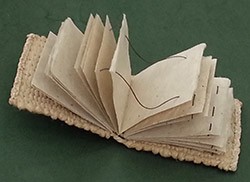 In June, I attended the Focus on Book Arts conference, and took Aimee Lee’s class “Paper like leather, Bark like thread: Korean Paper Techniques.” Over 3 days, we were introduced to various traditional Korean techniques of manipulating handmade paper and bark. One technique was jiseung, or paper weaving, which transforms strips of paper into cords that can be twined into all manner of objects, including baskets and book covers, like the one on the left.
In June, I attended the Focus on Book Arts conference, and took Aimee Lee’s class “Paper like leather, Bark like thread: Korean Paper Techniques.” Over 3 days, we were introduced to various traditional Korean techniques of manipulating handmade paper and bark. One technique was jiseung, or paper weaving, which transforms strips of paper into cords that can be twined into all manner of objects, including baskets and book covers, like the one on the left.
First Aimee boiled long pieces of kozo, the inner bark of the paper mulberry tree, which has long and strong fibers. After it was soft, we each got a piece to play with. The picture below is “bark lace,” where the fibers are tweezed apart to make a lacy pattern. Single strands can be pulled off to make thread.
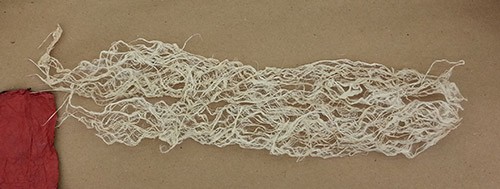
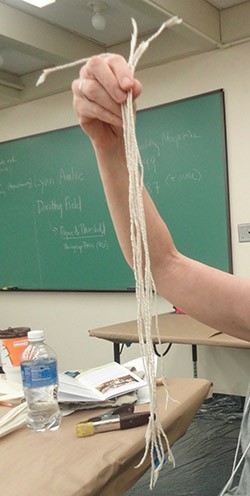 Then we cut parent sheets of hanji (paper made with kozo in the Korean technique) into long strips, and made two-ply cords out of them, by rubbing 2 strips together in our palms. I think we made 16, enough practice to really get the hang of the motions required to twine the strips as well as to get even tension (something I finally got on the last 2 cords). Here are my first attempts… Then we cut parent sheets of hanji (paper made with kozo in the Korean technique) into long strips, and made two-ply cords out of them, by rubbing 2 strips together in our palms. I think we made 16, enough practice to really get the hang of the motions required to twine the strips as well as to get even tension (something I finally got on the last 2 cords). Here are my first attempts…
|
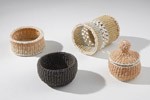 Then Aimee showed us how weave the cords (using a basket weave) to make “book covers.” In the picture below, I have reached then end of the cover—the non-woven space in the middle is for the spine of the book. As a non-crocheter, non-knitter and non-weaver, this was all a bit foreign. You can see I’ve dropped (or missed) some stitches, but I quite liked the handwork and repetition. Aimee showed us how to make a round basket as well, but I decided to make several book covers instead so I would be able to replicate the weave at home. While the class was working away. Aimee collected up all our scrap cords and made exquisite little baskets—no more than an inch wide, like the ones to the right.
Then Aimee showed us how weave the cords (using a basket weave) to make “book covers.” In the picture below, I have reached then end of the cover—the non-woven space in the middle is for the spine of the book. As a non-crocheter, non-knitter and non-weaver, this was all a bit foreign. You can see I’ve dropped (or missed) some stitches, but I quite liked the handwork and repetition. Aimee showed us how to make a round basket as well, but I decided to make several book covers instead so I would be able to replicate the weave at home. While the class was working away. Aimee collected up all our scrap cords and made exquisite little baskets—no more than an inch wide, like the ones to the right.
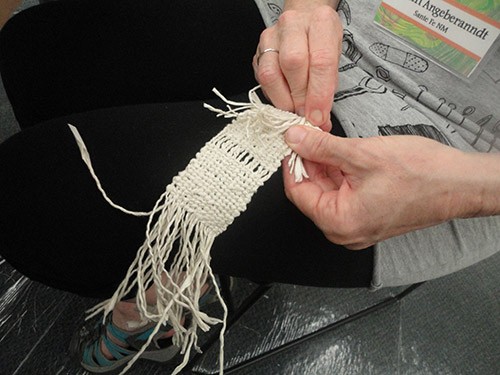
After the cover was done, I decided to cut my bark lace into “pages” and sew them, using the kozo thread, into the spine of the book. A completely hanji book… (I wasn’t quite done when the picture was taken, and that’s the kozo thread hanging off the back)
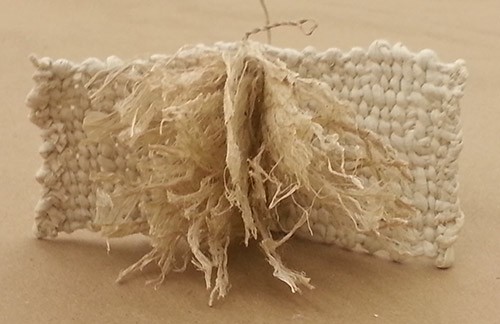
I like it very much because it is so unlike my other work—the cover is soft and unformed, the inside brittle. It’s not overly thought-out. Aimee told us that Koreans have used paper from books and official documents (with text on them) to weave baskets and animals and other forms, and this got to be a problem because people were stealing important papers to use in the weaving. I’m planning on letterpress printing secrets or poetry on large sheets of hanji, cutting them down, twining them and weaving to see what I get.
![]() Below is the book made by my table-mate Julie. She makes paper and knows how to knit, crochet, and weave. And she makes baskets. This could have been daunting, but she was really helpful when my fingers & brain refused to be coordinated and got me unstuck numerous times. She used her own paper for the inside of her book, and she died the cords with her own handmade dye before she wove the cords.
Below is the book made by my table-mate Julie. She makes paper and knows how to knit, crochet, and weave. And she makes baskets. This could have been daunting, but she was really helpful when my fingers & brain refused to be coordinated and got me unstuck numerous times. She used her own paper for the inside of her book, and she died the cords with her own handmade dye before she wove the cords.

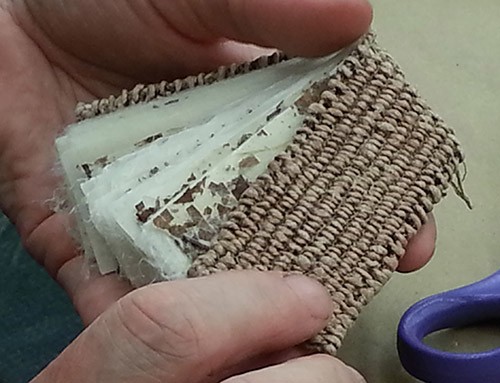
Wow! The photos are instructive and fascinating.
i love how you’ve stretched and have adapted aimee’s adaptations. wonderful post!
What a beautiful distillation of your class experience! After seeing such a huge range of your work, I’m not surprised by how elegantly you communicated the workshop. Such a pleasure to have you in class, and thanks for sharing!
I’ve seen Aimee Lee’s Korean adventure. It’s wonderful that she is now sharing her skills. Perhaps one day she will cross the pond and exhibit in the UK with complimentary workshop. I’d be first in line.
Thank you for sharing your experience, great post.